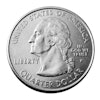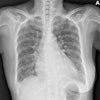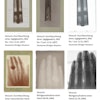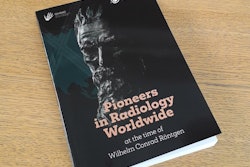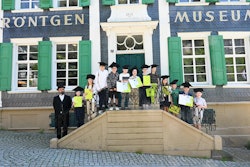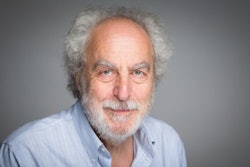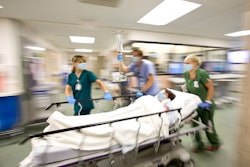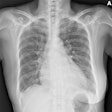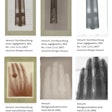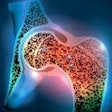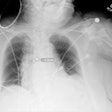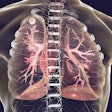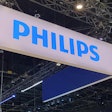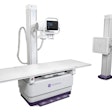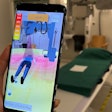I recently visited Lennep, 50 km west of Düsseldorf in Germany, for the symposium of the International Society for the History of Radiology (ISHRAD), which was held at the Deutsches Röntgen Museum (DRM). I had a great time, not the least when we were exploring the cafés, restaurants, and shops in the picturesque old town.
Remscheid-Lennep is the birthplace of Wilhelm Conrad Röntgen, who discovered x-rays in 1895, and the museum should be visited at least once by anyone at all interested in x-rays and radiology. Over the last couple of decades, the DRM has been transformed by its dynamic director Uwe Busch, PhD, and his team.
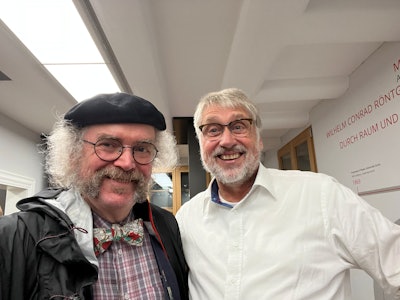 Dr. Adrian Thomas (left) and Uwe Busch, PhD, share a deep passion for radiology's history. Images courtesy of Dr. Adrian Thomas.
Dr. Adrian Thomas (left) and Uwe Busch, PhD, share a deep passion for radiology's history. Images courtesy of Dr. Adrian Thomas.
The DRM has changed from being a more traditional museum and now has something to appeal to everyone. Röntgen and radiology are presented in an exciting and innovative manner. The nearest airport is at Düsseldorf and Remscheid-Lennep is only a short journey away by train.
The museum dates back more than 75 years and gives a comprehensive account of the life, achievements, and impact of Röntgen, and it also shows the applications of x-rays in many areas. Röntgen won the first Nobel Prize in Physics in 1901, and this is fully recorded.
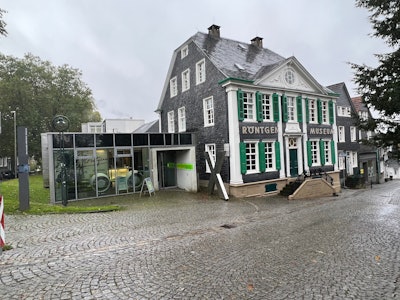 The Röntgen Museum has been extended and modernized over recent years.
The Röntgen Museum has been extended and modernized over recent years.
A huge amount of work was done recently on the archives, getting them into a good order. This was a major undertaking, and the museum staff must be congratulated. There is a wonderful collection of material to study, and a particularly impressive online archive plus many images can be downloaded.
I found their work on Röntgen's own holiday photographs particularly interesting. Extensive research using innovative modern methods helped to determine the exact locations where Röntgen took the photographs.
Emphasis on youth
The promotion of the radiological sciences for all ages is central to the work of the museum. There are age-appropriate and fascinating guided tours through the main exhibition. The teachings are appropriate for all school classes from primary school to secondary school, but they are also of interest to those of playschool or preschool age.
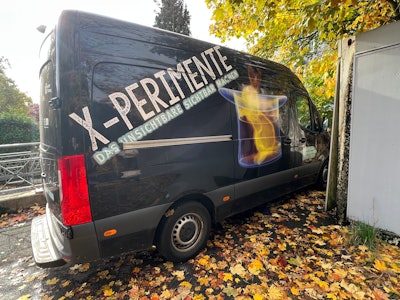 The DRM's X-PERIMENTE van is used for school visits.
The DRM's X-PERIMENTE van is used for school visits.
On the top floor, there is a modern laboratory for the use of students of all ages. In the children's Röntgen laboratory, the pupils can attend two to three-hour periods of various workshops in the RöLab, and there are events that offer pupils the possibility of carrying out experiments and also setting themselves interactive learning tasks. This enables their young guests to have a taste of laboratory life and to perhaps go home with a new inspiration for a possible career. There is also a well-equipped "X-PERIMENTE" van so that a team from the museum can take experiments to local schools.
Röntgen's place of birth
The house where Röntgen was born can be visited and is close to the museum. It has its own website, and it is in the heart of the old town. The house is cladded with slates and has the typical green shutters. It was acquired by the German Roentgen Society eV / Deutsche Rontgengesellschaft e.V. (DRG) and they have made the house into a brilliant resource.
When I first visited the house the ground floor was occupied with books, and I was able to sleep in the bedroom on the top floor. At that time the house resembled a traditional townhouse of the area.
 The house where Röntgen was born is typical of Bergisch housing of around 1800. It was listed as a historic monument and entered in the Remscheid city monument list in 1982.
The house where Röntgen was born is typical of Bergisch housing of around 1800. It was listed as a historic monument and entered in the Remscheid city monument list in 1982.
The house has now been completely modernized inside. The books are relocated, and the ground floor houses a public exhibition area where much interesting material about Röntgen and his family is displayed. On the first floor, there are meeting and conference rooms with desks and computers for study. Röntgen was always said to keep chocolate on his desk, and I was pleased that this tradition seems to be maintained! The lavatory is labeled as Röntgen WC! On the top floor, there is an apartment for guest and research fellows.
The house a now a point of reference for both professional scientists and the general public to study and research Rontgen and his rays.
The Röntgen Run (Röntgenlauf)
Are you a runner? The Röntgenlauf is a multiterrain running event held annually on the last Sunday of October in Lennep. There are runs for all ages and abilities. The 63.3 km ultramarathon takes the runners along the Röntgenweg, which is a hiking trail in the hills of the Bergisches Land around the city of Remscheid.
The start and the finish lines for the runs are at the Sportzentrum Hackenberg in Lennep in the eastern part of Remscheid. There are events for physicians, as well as children's and team runs. The longest route is very challenging (+1,370 meters of ascent) and varied and scenic, and it offers many fine views of the region's rich industrial heritage, including the graceful Müngstener Brücke (Müngsten Bridge), Germany's highest railway bridge.
Get involved in ISHRAD
The International Society for the History of Radiology (ISHRAD) is a vibrant society dedicated to the history of radiology and radiological technology and practice. There are members throughout the world, and at the symposium in Lennep, many interesting papers on the history and prehistory of radiology were presented.
The next ISHRAD symposium will be held during the French national congress, Journées Francophones de Radiologie (JFR), which will be organized by the Société Française de Radiologie (SFR) in Paris from 4 to 7 October 2024. The ISHRAD symposium will be on Saturday 5 Oct 2024. We hope to contribute to a booklet that will be produced by the French Radiology Museum on early radiology pioneers from around the world.
Please do consider joining ISHRAD, and possibly coming to our symposium in Paris. For more details, go to the ISHRAD website.
Dr. Adrian Thomas is treasurer and past chair of the International Society for the History of Radiology and honorary historian at the British Institute of Radiology.
